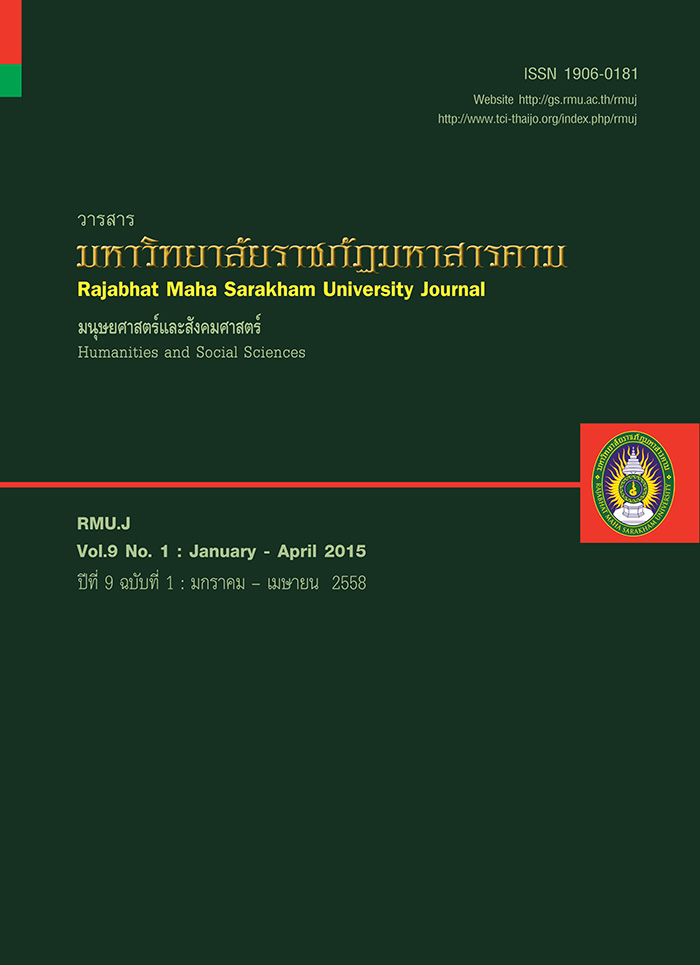รูปแบบการป้องกันและควบคุมโรคเลปโตสไปโรซิส ของประชาชนกลุ่มเสี่ยง จังหวัดศรีสะเกษ;A Model for Prevention and Control for Risk People of Leptospirosis Disease in Sisaket Province.
Main Article Content
บทคัดย่อ
การวิจัยครั้งนี้มีวัตถุประสงค์ ประการแรก เพื่อศึกษาปัจจัยเชิงสาเหตุที่มีผลต่อการป้องกันและควบคุมโรคเลปโตสไปโรซิสของ
ประชาชนกล่มุ เสีย่ ง จงั หวดั ศรสี ะเกษ ประการทีส่ อง เพื่อสรา้ งรปู แบบการปอ้ งกนั และควบคุมโรคเลปโตสไปโรซสิ ของประชาชนกลมุ่ เสีย่ ง
จังหวัดศรีสะเกษ และประการที่สาม เพื่อทดลองใช้และประเมินผล รูปแบบการป้องกันและควบคุมโรคเลปโตสไปโรซิสของประชาชน
กลุ่มเสี่ยง จังหวัดศรีสะเกษ วิธีดำเนินการวิจัยแบ่งเป็น 3 ระยะ คือ ระยะที่ 1 เป็นการวิจัยเชิงปริมาณ เพื่อศึกษาปัจจัยเชิงสาเหตุที่ส่ง
ผลทางตรงและส่งผลทางอ้อม ต่อการป้องกันและควบคุมโรคเลปโต สไปโรซิส โดยมีปัจจัยเชิงสาเหตุ 7 ปัจจัย คือ 1) ความรู้เรื่องโรค
เลปโตสไปโรซิส 2) การรับรู้ข้อมูลข่าวสาร 3) แรงจูงใจ 4) ความตระหนัก 5) ความเชื่อด้านสุขภาพ 6) เจตคติ และ7) การมีส่วนร่วม
กลมุ่ ตวั อยา่ งคอื ประชาชนกลมุ่ เสีย่ งตอ่ โรคเลปโตสไปโรซใิ นจังหวดั ศรสี ะเกษ จาํ นวน 400 คน ใชว้ ธิ กี ารสมุ่ ตัวอยา่ งแบบหลายขัน้ ตอน
(Multistage Random Sampling) เก็บข้อมูลโดยใช้แบบสอบถาม วิเคราะห์ข้อมูลโดยใช้สถิติวิเคราะห์การถดถอยพหุคูณ (Multiple
Linear Regression Analysis) และใช้รูปแบบการวิเคราะห์สมการเชิงโครงสร้าง (Structural Equation Model : SEM) โดยใช้โปร
แกรมลิสเรล (LISREL for Windows) เพื่ออธิบายอิทธิพลเส้นทาง (Path Analysis) หรือปัจจัยเชิงสาเหตุที่มีอิทธิพล ทั้งโดยตรงและ
โดยอ้อมต่อตัวแปรตาม ระยะที่ 2 เป็นการสร้างรูปแบบการป้องกันและควบคุมโรคเลปโตสไปโรซิส ของประชาชนกลุ่มเสี่ยง จังหวัด
ศรีสะเกษ ผู้วิจัยนำผลการวิจัยที่ได้จากการวิจัยระยะที่ 1 ไปสร้างรูปแบบการป้องกันและควบคุมโรคเลปโตสไปโรซิส ของประชาชน
กลุ่มเสี่ยง จังหวัดศรีสะเกษ โดยการจัดประชุมเชิงปฏิบัติการผู้เชี่ยวชาญ นักวิชาการ และผู้มีส่วนเกี่ยวข้อง จำนวน 30 คน ใช้การประชุม
กลุ่มย่อย (Focus Groups) เพื่อวิพากษ์และเสนอแนะเกี่ยวกับ รูปแบบการป้องกันและความคุมโรคเลปโตสไปโรซิส ที่ผู้วิจัย สร้างขึ้น
จากนั้นจึงนำมาอภิปรายและสรุปผลในที่ประชุมใหญ่ (Brian storming) ผู้วิจัยทำการปรับปรุงรูปแบบตามข้อเสนอแนะ แล้วส่งให้ผู้
เชี่ยวชาญ 3 ท่าน ประเมินความเหมาะสมของรูปแบบอีกครั้งให้สมบูรณ์ยิ่งขึ้นก่อนนำไปทดลองใช้ ระยะที่ 3 เป็นการทดลองใช้และ
ประเมินผลรูปแบบการป้องกันและควบคุมโรคเลปโตสไปโรซิส ของประชาชนกลุ่มเสี่ยง จังหวัดศรีสะเกษ กลุ่มทดลองคือ ประชาชน
กลุ่มเสี่ยงโรคเลปโตสไปโรซิส จำนวน 50 คน เปรียบเทียบผลการทดลองก่อนและหลังการใช้รูปแบบ และเปรียบเทียบกับกลุ่มควบคุม
จำนวน 50 คน ทำการวิเคราะห์ข้อมูลด้วยการวิเคราะห์ความแปรปรวนร่วมหลายตัวแปรตาม (Multivariate Analysis of Covariance
: MANCOVA) โดยใช้ค่าความรู้ก่อนการทดลอง เป็นตัวแปรควบคุม (Covariate) ผลการวิจัยพบว่า
This research aimed to 1) to analyze the casual factors affecting Leptospirosis disease prevention and
control for risk people in Sisaket province, 2) to design a model of Leptospirosis disease prevention and
control for risk people in Sisaket province, 3) to implement and evaluate the model of the Leptospirosis disease
prevention and control. The research methodology was divided into 3 phases. Phase 1 focused on the
quantitative research on the casual factors that affected directly and indirectly Leptospirosis disease prevention
and control for risk people in Sisaket province, and analysis of the relationships between the casual factors
to the empirical data. The multistage random sampling techniques was employed for sample selection. The
samples were four hundred risk people of Leptospirosis disease in Sisaket province. The data were collected
by questionnaires from the samples. Multiple linear regression was employed for data analysis, and LISREL
for windows was used to analyze a structural equation model. The casual factors affecting the dependent
variables were analyzed with the empirical data. Phase 2 focused on designing a model of Leptospirosis
disease prevention and control for risk people based on the data of phase 1 The model was designed through
workshop of thirty participants. The focus group method was employed for discussion on the model of
Leptospirosis disease prevention and control for risk people, and the developed model was assessed by
three experts. Phase 3 focused on implementing and evaluating the model. The model was implemented to
fifty experimental participants, and the model evaluation was identified by the comparison of the research
results before and after model implementation, and the comparison of the results of the experimental groups
and control group. Multivariate Analysis of Covariance was employed for data analysis. The major findings were as follows :
Article Details
1. บทความที่ลงตีพิมพ์ทุกเรื่องได้รับการตรวจทางวิชาการโดยผู้ประเมินอิสระ ผู้ทรงคุณวุฒิ (Peer Review) สาขาที่เกี่ยวข้อง อย่างน้อย 3 ท่าน ในรูปแบบ Double blind review
2. ข้อคิดเห็นใด ๆ ของบทความที่ลงตีพิมพ์ในวารสารมหาวิทยาลัยราชภัฏมหาสารคาม นี้เป็นของผู้เขียน คณะผู้จัดทำวารสารไม่จำเป็นต้องเห็นด้วย
3. กองบรรณาธิการวารสารมหาวิทยาลัยราชภัฏมหาสารคาม ไม่สงวนสิทธิ์การคัดลอกแต่ให้อ้างอิงแสดงที่มา

